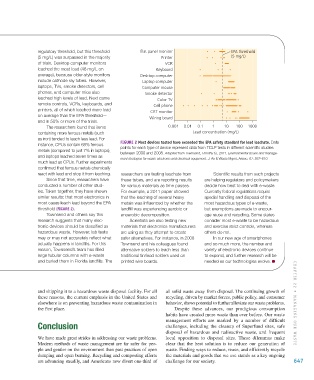Page 648 - Environment: The Science Behind the Stories
P. 648
regulatory threshold, but this threshold Flat panel monitor EPA threshold
(5 mg/L) was surpassed in the majority Printer (5 mg/L)
of trials. Desktop computer monitors VCR
leached the most lead (48 mg/L on Keyboard
average), because older-style monitors Desktop computer
include cathode ray tubes. However, Laptop computer
laptops, TVs, smoke detectors, cell Computer mouse
phones, and computer mice also Smoke detector
leached high levels of lead. Next came Color TV
remote controls, VCRs, keyboards, and Cell phone
printers, all of which leached more lead CRT monitor
on average than the EPA threshold— Wiring board
and in 50% or more of the trials.
The researchers found that items 0.001 0.01 0.1 1 10 100 1000
containing more ferrous metals (such Lead concentration (mg/L)
as iron) tended to leach less lead. For
instance, CPUs contain 68% ferrous FIGURE 2 Most devices tested have exceeded the EPA safety standard for lead leachate. Data
metals (compared to just 7% in laptops), points for each type of device represent data from TCLP tests in different scientific studies
and laptops leached seven times as between 2000 and 2008. Adapted from Townsend, Timothy G., 2011. Environmental issues and manage-
ment strategies for waste electronic and electrical equipment. J. Air & Waste Mgmt. Assoc. 61: 587–610.
much lead as CPUs. Further experiments
confirmed that ferrous metals chemically
react with lead and stop it from leaching. researchers are testing leachate from Scientific results from such projects
Since that time, researchers have these tubes, and are reporting results are helping regulators and policymakers
conducted a number of other stud- for various materials as time passes. decide how best to deal with e-waste.
ies. Taken together, they have shown For example, a 2011 paper showed Currently federal regulations require
similar results: that most electronics in that the leaching of several heavy special handling and disposal of the
most cases leach lead beyond the EPA metals was influenced by whether the most hazardous types of e-waste,
threshold (FIGURE 2). landfill was experiencing aerobic or but exemptions are made to encour-
Townsend and others say this anaerobic decomposition. age reuse and recycling. Some states
research suggests that many elec- Scientists are also testing new consider most e-waste to be hazardous
tronic devices should be classified as materials that electronics manufacturers and exercise strict controls, whereas
hazardous waste. However, lab tests are using as they attempt to create others do not.
may or may not accurately reflect what safer alternatives. For instance, in 2008 In our new age of smartphones
actually happens in landfills. For this Townsend and his colleagues found and so much more, the number and
reason, Townsend’s team has filled alternative solders to leach less than variety of electronic devices continue
large tubular columns with e-waste traditional tin/lead solders used on to expand, and further research will be
and buried them in Florida landfills. The printed wire boards. needed as our technologies evolve.
and shipping it to a hazardous waste disposal facility. For all all solid waste away from disposal. The continuing growth of
these reasons, the current emphasis in the United States and recycling, driven by market forces, public policy, and consumer
elsewhere is on preventing hazardous waste contamination in behavior, shows potential to further alleviate our waste problems. CHAPTER 22 • MAN A GING OUR WASTE
the first place. Despite these advances, our prodigious consumption
habits have created more waste than ever before. Our waste
management efforts are marked by a number of difficult
Conclusion challenges, including the cleanup of Superfund sites, safe
disposal of hazardous and radioactive waste, and frequent
We have made great strides in addressing our waste problems. local opposition to disposal sites. These dilemmas make
Modern methods of waste management are far safer for peo- clear that the best solution is to reduce our generation of
ple and gentler on the environment than past practices of open waste. Finding ways to reduce, reuse, and efficiently recycle
dumping and open burning. Recycling and composting efforts the materials and goods that we use stands as a key ongoing
are advancing steadily, and Americans now divert one-third of challenge for our society. 647
M22_WITH7428_05_SE_C22.indd 647 13/12/14 2:25 PM

